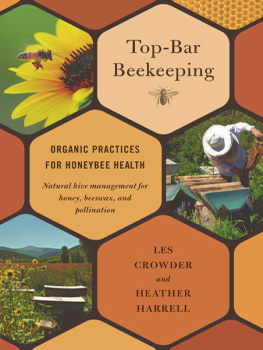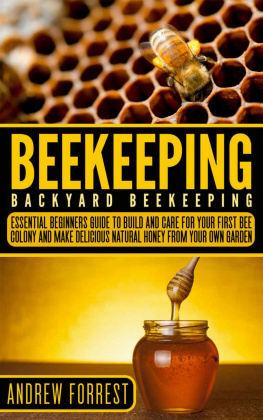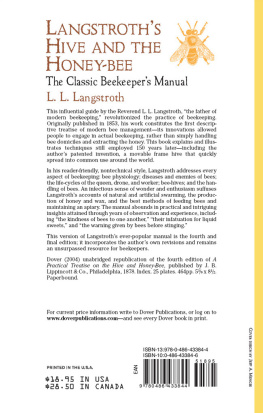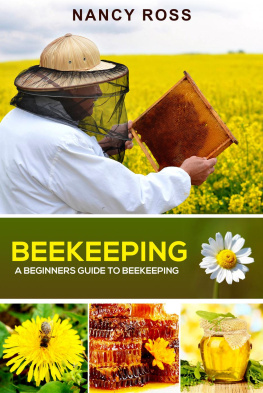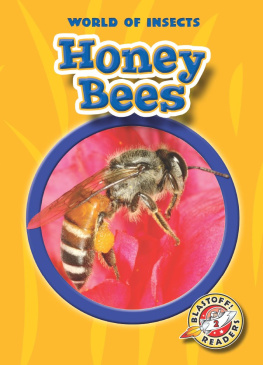First Lessons in
Beekeeping
Camille P. Dadant

Dover Publications, Inc.
Mineola, New York
Bibliographical Note
This Dover edition, first published in 2018, is an unabridged republication of the work originally published by the American Bee Journal, Hamilton, Illinois, in 1918.
Library of Congress Cataloging-in-Publication Data
Names: Dadant, C. P. (Camille Pierre), 18511938, author.
Title: First lessons in beekeeping / Camille P. Dadant.
Other titles: Beekeeping | American bee journal.
Description: Dover edition. | Mineola, New York: Dover Publications, Inc.,
2018. | Originally published: Hamilton, Illinois: American Bee Journal,
1918. | Includes index.
Identifiers: LCCN 2017033255 | ISBN 9780486819617 ] ISBN 0486819612
Subjects: LCSH: Bees. | Bee culture. | Honey.
Classification: LCC SF523 .D22 2018 | DDC 638/.1dc23 LC record available at https://lccn.loc.gove/2017033255
Manufactured in the United States by LSC Communications
81961201 2018
www.doverpublications.com
Introduction
BY DR. C. C. MILLER
Among those who were instrumental in introducing advanced methods in bee-culture among the beekeeepers of Europe in the last century, especially in overcoming opposition to the movable-frame hive, Charles Dadant stands forth conspicuous. In France Dadant and Dadant hive are household words among beekeepers. His great influence was used by means of his facile pen, for most of his life was spent in this country, where he was less known because he was not so familiar with the English language as with his native tongue, the French.
Yet his greatest legacy was not to France but to America. That legacy was his only son, Camille P. Dadant. Intimately associated with his father from his birth until the close of the long life of the father, the younger Dadant had a schooling as a beekeeper that can fall to the lot of few.
Mr. Dadant collaborated with his father in revising the great work of Langstroth. He has written much and well not only for the bee journals of this country, but of France as well. His very practical writings as editor of the American Bee Journal are well known.
All this, together with his long and successful career as a beekeeper gives warrant that the present work shall be a safe and sane guide to those entering upon the fascinating pursuit of beekeeping.
Marengo, Illinois, March 3, 1916.
C. C. MILLER
Preface
This short treatise for beginners is an entirely rewritten edition of the now exhausted book published in 1911 by George W. York and Co.
Less extensive than our revision of the Hive and Honey Bee, it yet contains the most practical of modern methods available in our day. But as simplicity is important, we have kept it in mind and difficult methods will not be found here. However a still more elementary work is given in our Bee Primer, which, at the low price of fifteen cents, has found a great welcome among prospective beekeepers.
This book is especially intended for colleges and schools giving short courses in bee culture. A few years ago such courses were not thought of. But they are annually becoming more numerous. Blind beekeeping is still less profitable than blind farming. The hive has long been a sealed book. It should be opened to the prospective apiarist before he attempts to keep bees. The bee owner who depends upon luck is an obstruction to the success of others, for disease and degenerescence of his bees are sure to follow from his lack of knowledge and method.
The different subjects treated in this work are marked, for reference, at the head of the paragraphs, with serial numbers. When reference is made to another part of the book, the serial number is inserted in parentheses, so that the student will easily find all references to the subject which he studies. Likewise, the index refers to the paragraphs and not to the pages of the book.
The different species of living animals number over a quarter of a million. Among this vast concourse of life, for instructive lessons none can rival the marvelous transformations that insect life undergoes in its development! The repulsive maggot of today may tomorrow be the active little fly, visiting leaf and flower. The repugnant caterpillar may tomorrow be decked with green and gold, through its speedy transformation to the butterfly, of brilliant tints and gorgeous beauty.
This is not more wonderful than are the transformations from the egg to the tiny larva, from the larva to the pupa, and from the pupa to the fully developed honeybee, with its wondrous instincts and marvelous habits. There is a fascination about the apiary that is indescribable. Every scientific beekeeper is an enthusiast. The economy of the beehive presents to the thoughtful student both admiration and delight.
A single bee, with all its energy, collects but a tiny drop of honey at each trip to the field, in the best season, yet the colony to which it belongs may harvest hundreds of pounds of surplus for its owner, in a single year.
In fructifying the flowers, too, bees present us with a field of study. Many plants absolutely require the visits of bees or other insects to disturb their pollen, and thus fertilize them. Hence, Darwin wisely remarks, when speaking of clover and heartsease: No bees, no seed, no increase of the flower; the more visits from the bees, the more seeds from the flower; the more seeds from the flowers, the more flowers from the seeds. Darwin mentions the following experiment: Twenty heads of white clover, visited by bees, produced an average of twenty-seven seeds per head; while twenty heads, so protected that bees could not visit them, produced not one seed.
Since the Darwin experiment, hundreds of scientists have made tests of this same subject. Bulletin No. 289 of the United States Department of Agriculture, published September 21, 1915, details at length the experiments made at the Indiana Experiment Station by Messrs. Wiancko and Robbins and at the Iowa Experiment Station of Ames, by Messrs. Hughes, Pammel and Martin. They confirm Darwins statements and show that clover can produce only an occasional seed from self pollination, that the pollen must come from a separate plant in order to effect fertilization. They also show that the honeybee is as efficient a pollinator of red clover as the bumblebee, whenever it is able, by the shortness of the corolla, to work upon it.
Ancient sages, among whom were Homer, Herodotus, Cato, Aristotle, Varro, Virgil, Pliny and Columella, composed poems extolling the activity, skill and economy of bees, and in modern times among such authors have been Swammerdam, a Dutch naturalist; Maraldi, an Italian mathematician and astronomer; Schirach, a Saxon agriculturist; Reaumur, inventor of a thermometor; Butler, who first asserted the existence of a queen bee; Wildman; Della Rocca; Duchet; Bonnet, a Swiss entomologist; Dr. John Hunter; and Francis Huber, who, though totally blind, was noted for his many minute observations, by aid of his assistant, Burnens, which caused quite a revolution in ancient theories concerning honeybees. Nearer to our day, we may mention as the leaders of modern practical apiculture: Dzierzon, Von Siebold, John Lubbock, L. L. Langstroth, Samuel Wagner, M. Quinby, Adam Grimm, J. S. Harbison, Capt. J. E. Hetherington, Prof. A. J. Cook, G. M. Doolittle, Dr. C. C. Miller, A. I. Root and his sons, Chas. Dadant, E. W. Alexander, Thos. Wm. Cowan, Frank R. Cheshire, Edward Bertrand, and a host of others.


